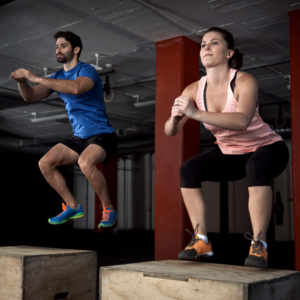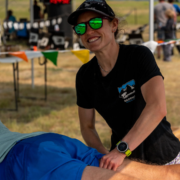If you have ever trained for a sport or participated in a regular exercise routine, you have likely heard of plyometrics. Plyometric training is a useful tool not only for athletes but also is an important component in physical therapy as way to help patients return to sport and activity. Though plyometrics are typically thought of as an exercise for more explosive sports, runners should be adding in this to their normal routine as well.
What Are Plyometrics?
Plyometrics are a form of training that utilizes our body’s stretch-shortening cycle to produce powerful, explosive movements. Both speed(time) and strength(force) are functions of power and can be manipulated to achieve varying outcomes. This stretch-shortening cycle in our muscles can be thought of as a spring being compressed and released (1).
Benefits of plyometrics
The primary goal when performing plyometric training is to increase our body’s power output to improve our performance during athletic maneuvers. For runners, this means increasing our running economy or improve the efficiency at which we run. Plyometrics have been shown to improve running economy as well as increase tendon stiffness and bone density (1, 2). This is especially important considering how prevalent tendon and bone injuries are in the sport of distance running.
How to perform plyometrics
Plyometrics require an ‘explosive’ movement. Near maximal effort should be used when doing plyometrics to maximize the potential benefits, which is part of what makes plyometric training so great. Because of the level of demand placed on the body, individuals do not need to perform countless repetitions to achieve their goal. Depending on the amount of running you are doing, it is best to start with one set of ten repetitions for each type of jump, two to three times a week and then add additional sets from there.
While plyometrics can be beneficial, we suggest consulting with your local physical therapist regarding any questions or concerns about your ability to implement plyometric training.
Examples of Plyometrics for Runners:
- Double leg hop for distance
- Single leg hop for distance
- Counter movement jump (step off box and quickly follow with jump)
For more information on plyometrics, visit the Sapphire PT blog here: https://www.sapphirephysicaltherapy.com/blog/plyometric-training
By: Andrew Traver, Student of Physical Therapy/Sapphire Physical Therapy Clinical Intern
References:
1 Voight, Michael L., and Steven R. Tippett. “Plyometric Exercise in Rehabilitation.” Musculoskeletal Interventions: Techniques for Therapeutic Exercise, Third Edition Eds. Barbara J. Hoogenboom, et al. McGraw Hill, 2013, https://accessphysiotherapy.mhmedical.com/content.aspx?bookid=960§ionid=53549678.
2 Davies, George et al. “CURRENT CONCEPTS OF PLYOMETRIC EXERCISE.” International journal of sports physical therapy vol. 10,6 (2015): 760-86.





